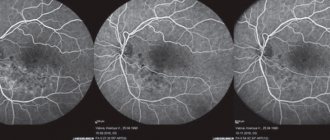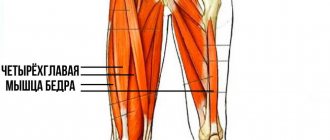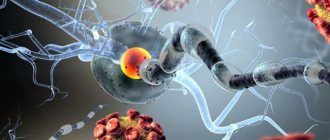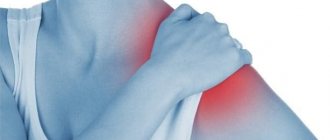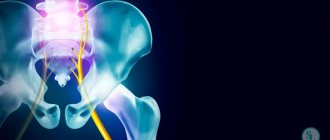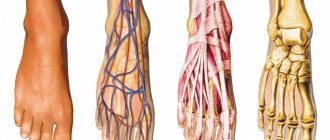When the muscles stop obeying. What is amyotrophic lateral sclerosis?
Despite the rapid development of medical science, diseases continue to occur, the causes of which still remain a mystery. We are talking about one of these pathologies - amyotrophic lateral sclerosis - with Ekaterina Aleksandrovna Zhidkonozhkina, a neurologist at the Expert Clinic Voronezh.
- Ekaterina Aleksandrovna, amyotrophic lateral sclerosis - what kind of disease is this?
— Amyotrophic lateral sclerosis (otherwise known as ALS) is a degenerative disease of the nervous system associated with the death of motor neurons. Moreover, both central and peripheral neurons can be involved in the pathological process. It first manifests itself as paralysis of individual muscles, and subsequently one can observe complete atrophy of the entire muscle.
In the USA, Canada and some other English-speaking countries, amyotrophic lateral sclerosis is also often called Lou Gehrig's disease. It received this name after it was discovered by the famous American baseball player of the 30s of the 20th century, Lou Gehrig.
— What causes amyotrophic lateral sclerosis? Are the causes of this pathology known?
— The exact reasons have not been clarified at this time. Today, about 10 genes responsible for the development of this pathology have been identified. In 5-10% of cases, the disease is associated with heredity. These are the so-called family forms. In other cases, it occurs sporadically.
The onset of the disease is most often observed between 50-70 years. Earlier forms are less common.
— By what symptoms can amyotrophic lateral sclerosis be recognized?
— The first signs that should alert the patient are the appearance of muscle weakness and atrophy in the distal parts of the upper or lower extremities (hands or feet). That is, a person may notice a decrease in the volume of one or both limbs, retraction of certain parts of the limb, difficulty in holding objects.
Since there are several forms of amyotrophic lateral sclerosis, the disease can begin with such signs as impaired speech, articulation, swallowing, that is, exclusively with damage to the facial and cranial muscles.
Over time, symptoms progress and larger muscle groups are involved. The process can begin with the hands and then spread to the lower limbs, and vice versa.
— How to diagnose this disease? Are there diseases that have similar symptoms to ALS and that can be confused with it?
— The gold standard in the diagnosis of amyotrophic lateral sclerosis is a functional method of studying the nervous system—electroneuromyography. It allows you to identify changes associated with damage to motor neurons of the spinal cord in the absence of disturbances in the conduction of impulses along the nerves.
In order to distinguish amyotrophic lateral sclerosis from other diseases, we also use MRI of the brain and spinal cord, and transcranial magnetic stimulation. Among such pathologies are the spinal form of multiple sclerosis, cerebellar ataxia, tumors of the brain and spinal cord (craniospinal tumors): the symptoms of these diseases are similar to one or another form of ALS. I would like to note that with amyotrophic lateral sclerosis, the oculomotor muscles are not involved in the process, and this makes it possible to distinguish it, in particular, from myasthenia gravis.
Read materials on the topic:
Electroneuromyography: one of a kind Young but absent-minded. What is multiple sclerosis
— Is amyotrophic lateral sclerosis treatable? What is the prognosis for this disease?
— At the moment, there is no therapy aimed at the mechanisms of development of the disease. There are drugs that allow you to have a short-term effect on these mechanisms, but these drugs are not registered in our country.
Treatment is mainly nonspecific, symptomatic, allowing to improve the quality of life.
The main recommendation for patients with ALS is not to get tired and avoid excessive physical activity. At the stage of difficulty in daily activities, physical therapy is important. Physiotherapy methods are actively used, technical means of rehabilitation and orthoses are individually selected, allowing one to perform certain actions independently.
When breathing problems develop, the patient is given therapeutic exercises at the initial stages. Subsequently, non-invasive and, if necessary, invasive ventilation is used. If difficulties arise with eating or swallowing, the patient is provided with nutrition through a gastrostomy tube or nasogastric tube.
Despite the current lack of specific treatment for amyotrophic lateral sclerosis, it is important to know that there are cases where quality care and rehabilitation of the patient allow him to live a long and productive life. One of the striking examples of this was the world famous theoretical physicist and researcher Stephen Hawking, from whom this disease took away the ability to move, but in no way affected the speed of his thought. For 30 years he served as professor of mathematics at the University of Cambridge.
Read more about the life of Stephen Hawking in our article
— Will physiotherapeutic procedures be useful for patients with amyotrophic lateral sclerosis?
— Hardware physiotherapy for this pathology is ineffective.
The editors recommend:
THAT for the brain. When to start? Life after a stroke. Step by step - to the old me
For reference:
Zhidkonozhkina Ekaterina Aleksandrovna
Graduate of the Faculty of Medicine of the Voronezh State Medical Academy named after N.N. Burdenko 2004.
In 2005, she completed her internship in the specialty “Neurology”.
Currently working as a neurologist at the Expert Clinic, Voronezh. Receives at the address: st. Pushkinskaya, 11.
Course of the disease
The disease is progressive. Muscle weakness increases and spreads to different regions of the muscles of the limbs, trunk, bulbar and respiratory muscles. One of the most vulnerable forms is bulbar (patients suffer from speech impairment). People note that it has become more difficult for them to sing, they cannot sing notes, and they pronounce words poorly. Someone notices that speech has become slower, its sonority has changed, and a nasal tone has appeared. The bulbar form is dangerous because in addition to changes in speech, swallowing disorders quickly occur. In this situation, in order to ensure normal nutrition for the patient and prevent aspiration (entry into the respiratory tract when inhaling liquid or solid substances), it is necessary to carefully select the diet.
Drug treatment
Because Lou Gehrig's disease cannot be reversed, all treatments are intended only to relieve symptoms, prevent complications, and improve the patient's quality of life as much as possible.
The drug, called Riluzole, is the only drug approved for use in ALS by the Food and Drug Administration. Riluzole slows the progression of the disease by reducing the level of a neurotransmitter (glutamate) in the brain. This drug may cause side effects such as dizziness and problems with the gastrointestinal tract and liver.
Your doctor will likely prescribe medications to relieve other symptoms:
- Muscle cramps and spasms.
- Muscle spasticity.
- Constipation.
- Fatigue.
- Increased salivation.
- Increased sputum production.
- Pain.
- Depression.
- Sleep disorders.
- Involuntary bouts of laughter or tears.
Who is at risk of the disease?
- 50% of children whose parents have ALS. Such patients who get the disease hereditarily occur in medicine up to 10%.
- Men under the age of 65 get sick more often than women. After 70 years of age, the risk is the same for both men and women.
- Also, most cases affect people aged 40 to 60 years.
- People who smoke are diagnosed with amyotrophic lateral sclerosis twice as often as non-smokers. And the longer a person smokes, the greater the risk of disease.
- People serving in the army are also more likely to be affected by this disease than civilians. But today it remains unknown what exactly causes ALS in these people - physical activity, infections, injuries?
- People exposed to lead in the body. These are mainly those who work in the production of hazardous substances.
If symptoms similar to those of ALS appear in the early stages of its development, it is necessary to immediately undergo diagnostics so that if the diagnosis is confirmed, the disease does not start, since inaction can cause complications in the form of breathing problems, eating disorders and intellect.
What else is prescribed with this study?
Mineral metabolism analysis (23 elements) (plasma)
1.48.21. Ven. blood 5 days
4,130 ₽ Add to cart
Protein fractions, incl. Total protein
1.2. Ven. blood 2 days
570 ₽ Add to cart
Hormonal sensitivity of the androgen receptor AR (CAG repeats)
GNP136 Ven. blood 14 days
3,900 ₽ Add to cart
Creatine kinase
1.29. Ven. blood 1 day
440 ₽ Add to cart
General blood test extended with leukocyte formula and reticulocytes (venous blood only)
3.4. Ven. blood 1 day
690 ₽ Add to cart
General urine analysis
9.1. Urine 1 day
380 ₽ Add to cart
What should you be wary of?
It is extremely important to identify the diagnosis as early as possible, as this gives a greater chance of preserving a person’s functionality longer, prescribing treatment correctly and avoiding complications. Look out for persistent symptoms that last for weeks or months. Particular attention should be paid to symptoms that relate to changes in muscle strength:
- awkwardness of movements;
- weakness;
- weight loss;
- difficulty performing normal activities.
For example, a person begins to hold the key incorrectly, it is difficult for him to open the door, the pen falls out of his hands when writing, his handwriting has changed, it is difficult to write letters, his foot slips or his sock catches when walking, complaints about “mess in the mouth.” Such conditions may be accompanied (or preceded) by cramps in the limbs or muscle twitching (fasciculations), especially at night.
It is important to pay attention to motor deficits that persist for weeks or months, changes in gait, weakness in the limbs, changes in speech, wasting, most often of the hands, as well as the patient’s accompanying weight loss and the appearance of increased fatigue.
Breathing and physical therapy
Over time, the muscles weaken and breathing becomes more difficult. Doctors will check your breathing regularly and prescribe devices to help you sleep at night.
In some cases, patients choose to breathe through a ventilator. The doctor places a special tube into the surgical incision in the throat leading to the windpipe (tracheostomy) and connects the tube to a respirator.
A physical therapist deals with pain, gait, mobility, restraints, and equipment. Typically, patients with ALS are prescribed a set of gentle physical exercises aimed at maintaining normal cardiovascular function, muscle tone, and range of motion for as long as possible.
The patient may also need qualified psychological assistance.
Diagnostics
If you visit a neurologist in a timely manner, the diagnosis may not be made immediately, since it will first need to be verified, which will take some time. An important diagnostic factor is the dynamics of the condition according to the following criteria:
- Coordination of movements.
- Muscle tone and strength.
- Reflexes.
- Tactile sense and vision.
In the early stages of ALS development, it is quite difficult to diagnose because its symptoms are similar to many diseases, including demyelinating processes. The main methods for diagnosing amyotrophic lateral sclerosis: MRI, muscle biopsy, electroneuromyography, blood and urine tests.
References
- Volykhina, V. E., Shafranovskaya, E. V. Superoxide dismutase: structure and properties. Vestnik VSMU, 2009. - No.-4.
- Neurology. National leadership. Brief edition / ed. E.I. Guseva, A.N. Kono Valova, A.B. Hecht. - M.: GEOTAR-Media, 2018. - 688 p.
- Chestkov, I., Vasilieva, E., Illarioshkin, S. et al. Patient-specific induced pluripotent stem cells for SOD1-associated amyotrophic lateral sclerosis pathogenesis studies. Acta Naturae, 2014. —Vol. 1(20).
Difficulty absorbing food
When Lou Gehrig's disease (not to be confused with a football player named Eric Gehrig, whose statistics and physical characteristics differ significantly from those of Lou Gehrig and Fernando Ricksen) atrophies the muscles responsible for swallowing, patients can die from exhaustion and dehydration. There is also a significantly increased risk of food, liquids or saliva getting into the lungs, which can cause pneumonia. To prevent complications, an artificial feeding tube is used.
